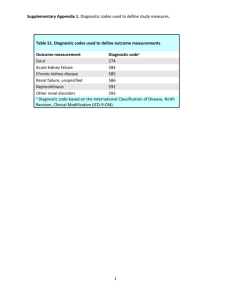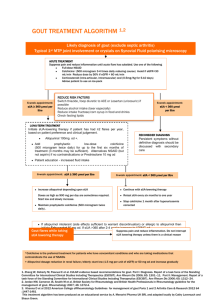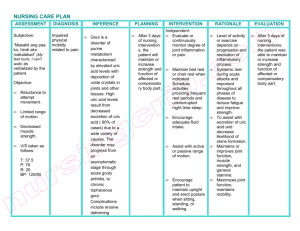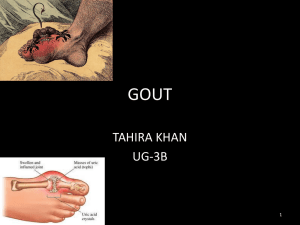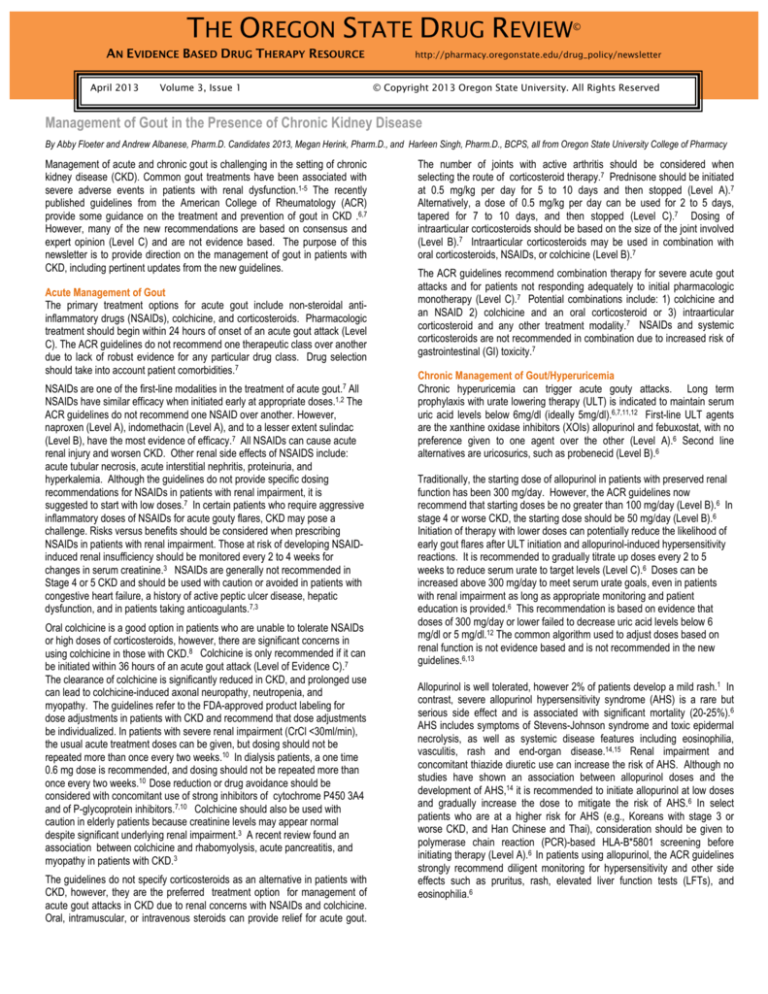
THE OREGON STATE DRUG REVIEW
AN EVIDENCE BASED DRUG THERAPY RESOURCE
April 2013
Volume 3, Issue 1
©
http://pharmacy.oregonstate.edu/drug_policy/newsletter
© Copyright 2013 Oregon State University. All Rights Reserved
Management of Gout in the Presence of Chronic Kidney Disease
By Abby Floeter and Andrew Albanese, Pharm.D. Candidates 2013, Megan Herink, Pharm.D., and Harleen Singh, Pharm.D., BCPS, all from Oregon State University College of Pharmacy
Management of acute and chronic gout is challenging in the setting of chronic
kidney disease (CKD). Common gout treatments have been associated with
severe adverse events in patients with renal dysfunction.1-5 The recently
published guidelines from the American College of Rheumatology (ACR)
provide some guidance on the treatment and prevention of gout in CKD .6,7
However, many of the new recommendations are based on consensus and
expert opinion (Level C) and are not evidence based. The purpose of this
newsletter is to provide direction on the management of gout in patients with
CKD, including pertinent updates from the new guidelines.
Acute Management of Gout
The primary treatment options for acute gout include non-steroidal antiinflammatory drugs (NSAIDs), colchicine, and corticosteroids. Pharmacologic
treatment should begin within 24 hours of onset of an acute gout attack (Level
C). The ACR guidelines do not recommend one therapeutic class over another
due to lack of robust evidence for any particular drug class. Drug selection
should take into account patient comorbidities.7
NSAIDs are one of the first-line modalities in the treatment of acute gout.7 All
NSAIDs have similar efficacy when initiated early at appropriate doses.1,2 The
ACR guidelines do not recommend one NSAID over another. However,
naproxen (Level A), indomethacin (Level A), and to a lesser extent sulindac
(Level B), have the most evidence of efficacy.7 All NSAIDs can cause acute
renal injury and worsen CKD. Other renal side effects of NSAIDS include:
acute tubular necrosis, acute interstitial nephritis, proteinuria, and
hyperkalemia. Although the guidelines do not provide specific dosing
recommendations for NSAIDs in patients with renal impairment, it is
suggested to start with low doses.7 In certain patients who require aggressive
inflammatory doses of NSAIDs for acute gouty flares, CKD may pose a
challenge. Risks versus benefits should be considered when prescribing
NSAIDs in patients with renal impairment. Those at risk of developing NSAIDinduced renal insufficiency should be monitored every 2 to 4 weeks for
changes in serum creatinine.3 NSAIDs are generally not recommended in
Stage 4 or 5 CKD and should be used with caution or avoided in patients with
congestive heart failure, a history of active peptic ulcer disease, hepatic
dysfunction, and in patients taking anticoagulants.7,3
Oral colchicine is a good option in patients who are unable to tolerate NSAIDs
or high doses of corticosteroids, however, there are significant concerns in
using colchicine in those with CKD.8 Colchicine is only recommended if it can
be initiated within 36 hours of an acute gout attack (Level of Evidence C).7
The clearance of colchicine is significantly reduced in CKD, and prolonged use
can lead to colchicine-induced axonal neuropathy, neutropenia, and
myopathy. The guidelines refer to the FDA-approved product labeling for
dose adjustments in patients with CKD and recommend that dose adjustments
be individualized. In patients with severe renal impairment (CrCl <30ml/min),
the usual acute treatment doses can be given, but dosing should not be
repeated more than once every two weeks.10 In dialysis patients, a one time
0.6 mg dose is recommended, and dosing should not be repeated more than
once every two weeks.10 Dose reduction or drug avoidance should be
considered with concomitant use of strong inhibitors of cytochrome P450 3A4
and of P-glycoprotein inhibitors.7,10 Colchicine should also be used with
caution in elderly patients because creatinine levels may appear normal
despite significant underlying renal impairment.3 A recent review found an
association between colchicine and rhabomyolysis, acute pancreatitis, and
myopathy in patients with CKD.3
The guidelines do not specify corticosteroids as an alternative in patients with
CKD, however, they are the preferred treatment option for management of
acute gout attacks in CKD due to renal concerns with NSAIDs and colchicine.
Oral, intramuscular, or intravenous steroids can provide relief for acute gout.
The number of joints with active arthritis should be considered when
selecting the route of corticosteroid therapy.7 Prednisone should be initiated
at 0.5 mg/kg per day for 5 to 10 days and then stopped (Level A).7
Alternatively, a dose of 0.5 mg/kg per day can be used for 2 to 5 days,
tapered for 7 to 10 days, and then stopped (Level C).7 Dosing of
intraarticular corticosteroids should be based on the size of the joint involved
(Level B).7 Intraarticular corticosteroids may be used in combination with
oral corticosteroids, NSAIDs, or colchicine (Level B).7
The ACR guidelines recommend combination therapy for severe acute gout
attacks and for patients not responding adequately to initial pharmacologic
monotherapy (Level C).7 Potential combinations include: 1) colchicine and
an NSAID 2) colchicine and an oral corticosteroid or 3) intraarticular
corticosteroid and any other treatment modality.7 NSAIDs and systemic
corticosteroids are not recommended in combination due to increased risk of
gastrointestinal (GI) toxicity.7
Chronic Management of Gout/Hyperuricemia
Chronic hyperuricemia can trigger acute gouty attacks. Long term
prophylaxis with urate lowering therapy (ULT) is indicated to maintain serum
uric acid levels below 6mg/dl (ideally 5mg/dl).6,7,11,12 First-line ULT agents
are the xanthine oxidase inhibitors (XOIs) allopurinol and febuxostat, with no
preference given to one agent over the other (Level A).6 Second line
alternatives are uricosurics, such as probenecid (Level B).6
Traditionally, the starting dose of allopurinol in patients with preserved renal
function has been 300 mg/day. However, the ACR guidelines now
recommend that starting doses be no greater than 100 mg/day (Level B).6 In
stage 4 or worse CKD, the starting dose should be 50 mg/day (Level B).6
Initiation of therapy with lower doses can potentially reduce the likelihood of
early gout flares after ULT initiation and allopurinol-induced hypersensitivity
reactions. It is recommended to gradually titrate up doses every 2 to 5
weeks to reduce serum urate to target levels (Level C).6 Doses can be
increased above 300 mg/day to meet serum urate goals, even in patients
with renal impairment as long as appropriate monitoring and patient
education is provided.6 This recommendation is based on evidence that
doses of 300 mg/day or lower failed to decrease uric acid levels below 6
mg/dl or 5 mg/dl.12 The common algorithm used to adjust doses based on
renal function is not evidence based and is not recommended in the new
guidelines.6,13
Allopurinol is well tolerated, however 2% of patients develop a mild rash.1 In
contrast, severe allopurinol hypersensitivity syndrome (AHS) is a rare but
serious side effect and is associated with significant mortality (20-25%).6
AHS includes symptoms of Stevens-Johnson syndrome and toxic epidermal
necrolysis, as well as systemic disease features including eosinophilia,
vasculitis, rash and end-organ disease.14,15 Renal impairment and
concomitant thiazide diuretic use can increase the risk of AHS. Although no
studies have shown an association between allopurinol doses and the
development of AHS,14 it is recommended to initiate allopurinol at low doses
and gradually increase the dose to mitigate the risk of AHS.6 In select
patients who are at a higher risk for AHS (e.g., Koreans with stage 3 or
worse CKD, and Han Chinese and Thai), consideration should be given to
polymerase chain reaction (PCR)-based HLA-B*5801 screening before
initiating therapy (Level A).6 In patients using allopurinol, the ACR guidelines
strongly recommend diligent monitoring for hypersensitivity and other side
effects such as pruritus, rash, elevated liver function tests (LFTs), and
eosinophilia.6
OREGON STATE DRUG REVIEW
Page 2
Another ULT first-line option for the treatment of chronic gout is febuxostat. In
contrast to allopurinol, febuxostat is metabolized by hepatic glucuronidation
and oxidation.16 Renal elimination plays only a small role in febuxostat
pharmacokinetics, therefore, it does not require renal dose adjustment in mild
to moderate CKD.16,17,18 Evidence is lacking on the safety of febuxostat in
stage 4 CKD or worse, and there is no safety data regarding febuxostat in
patients with a history of allopurinol hypersensitivity.16,19 The usual starting
dose of febuxostat is 40 mg/day with a maximum FDA-approved dose of 80
mg/day.16 The ACR guidelines endorse titrating up to 120 mg/day (used
outside USA) in patients with refractory gout despite FDA labeling.6
When managing gout on a chronic basis, it is reasonable to substitute one XOI
for another in patients who experience intolerable side effects, or if the serum
urate goal is not achieved with the current XOI (Level C).6 The ACR
guidelines recommend regular monitoring of serum urate every 2 to 5 weeks
during ULT titration and continuing measurements every 6 months once the
serum urate target is achieved.6
Although the guidelines do not preferentially recommend one XOI over
another, febuxostat treatment is significantly more expensive than allopurinol.
A one month supply of febuxostat 40 mg/day costs approximately $192
compared to a month supply of allopurinol 300 mg/day costing approximately
$24.20 The National Institute for Health and Clinical Excellence (NICE)
recommends that febuxostat be reserved for patients intolerant to allopurinol,
due to cost differences.21
The uricosuric agent probenecid is considered an alternative first-line ULT
option in patients with a contraindication or intolerance to a XOI (Level B).6
Probenecid is not recommended in patients with a creatinine clearance less
than 50 ml/min and shown to be ineffective when GFR is 30 mL/min or
less.3,6 The guidelines suggest other agents with uricosuric effects, such as
fenofibrate or losartan, should be utilized (Level B).6 In disease refractory to
XOIs, the addition of an agent with uricosuric effects can be considered (Level
B).6
Gout Attack Prophylaxis
Prophylaxis against acute flares is advised during the initiation of ULT
because rapid lowering of serum urate levels is associated with gout flares.
The ACR guidelines recommend prophylaxis with low-dose colchicine (0.6 mg
once or twice a day) or low-dose NSAIDs (naproxen 250 mg orally twice daily)
as acceptable first-line options, with a higher evidence level for colchicine
(Level A).7 In patients with severe renal impairment (CrCl <30ml/min), the
recommended starting dose of colchicine is 0.3 mg/day. For patients on
dialysis, the starting dose is 0.3 mg twice a week.10 In CKD even reduced
doses of colchicine can lead to toxicity.
Despite limited data, low-dose (≤ 10 mg daily) prednisone or prednisolone are
recommended if first-line agents fail to prevent acute attacks (Level C).7 The
risks associated with prolonged corticosteroid therapy should be considered.7
The length of therapy is determined by the presence of tophi and the
attainment of target serum urate levels. The ACR guidelines recommend
continuation of prophylactic therapy for the greater of the following: 6 months
duration (Level A), 3 months after achieving target serum urate levels in
patients without tophi (Level B) or 6 months after achieving target serum urate
levels in patients where there has been resolution of tophi (Level C).7
Non-pharmacologic Therapy
The ACR guidelines do not recommend complimentary therapies such as
cherry juice, ginger, flaxseed, or charcoal.7 Topical ice can be used in
conjunction with other pharmacological therapies (Level B).7 Lifestyle and
dietary measures such as losing weight, avoiding foods rich in purines,
smoking cessation, limiting alcohol consumption, and consuming vegetables
are encouraged by the guidelines.6,7
Evidence Grades for Recommendations
Level A: Supported by multiple (i.e., ≥1) randomized clinical trials or meta-analyses
Level B: Derived from a single randomized trial, or nonrandomized studies
Level C: Consensus opinion of experts, case studies, or standard-of-care
Peer Reviewed By: Stephen Campbell, MD, Providence Medical Group and Nanette
Bultemeier, PharmD, BCPS, BC-ADM, CDE, Clinical Pharmacy Specialist, Providence
Medical Group.
References
1.
Neogi T. Gout. N Eng J Med 2011;364:443-52.
2.
Stamp L, Jordan S. The challenges of gout management in the elderly. Drugs
Aging 2011;28(8):591-603.
3.
Curiel R, Guzman N. Challenges associated with the management of gouty
arthritis in patients with chronic kidney disease: a systematic review. Semin
Arthritis Rheum 2012;42(2):166-78.
4.
El-zawawy H, Mandell B. Managing gout: how is it different in patients with
chronic kidney disease? Cleve Clin J Med 2010;77(12):919-928.
5.
Marwah R. Comorbidities in gouty arthritis. J Investig Med 2011;59:1211-1220
6.
Khanna D, Fitzgerald J, Khanna P, et al. 2012 American College of
Rheumatology guidelines for management of gout. Part 1: systematic
nonpharmacologic and pharmacologic therapeutic approaches to hyperuricemia.
Arthritis Care Res 2012;64(10):1431-46.
7.
Khanna D, Khanna P, Fitzgerald J, et al. 2012 American College of
Rheumatology guidelines for management of gout. Part 2: therapy and antiinflammatory prophylaxis of acute gouty arthritis. Arthritis Care Res
2012;64(10):1447-61.
8.
El-Zawawy H. Managing gout: How is it different in patients with chronic kidney
disease? Cleveland Clinic Journal of Medicine 2010;77(12)919-928.
9.
Terkeltaub R, Furst D, Bennett K, et al. High versus low dosing of oral colchicine
for early acute gout flare: twenty-four-hour outcome of the first multicenter,
randomized, double-blind, placebo-controlled, parallel group, dose-comparison
colchicine study. Arthritis Rheum 2010;62:1060-8.
10. Colcrys [Package Insert]. Deerfield, IL: Takeda Pharmaceuticals American, Inc.
June 2012.
11. Zhang W, Doherty M, Bardin T, et al. EULAR evidence based recommendations
for gout. Part II: Management. Report of a task force of the EULAR Standing
Committee for International Clinical Studies Including Therapeutics (ESCISIT).
Ann Rheum Dis 2006;65:1312-24.
12. Dalbeth N, Kumar S, Stamp L, et al. Dose adjustment of allopurinol according to
creatinine clearance does not provide adequate control of hyperuricemia in
patients with gout. J Rheumatol 2006;33:1646-50.
13. Hande K, Noone R, Stone W. Severe allopurinol toxicity. Description and
guidelines for prevention in patients with renal insufficiency. Am J Med
1984;76(1):47-56.
14. Arellano F, Sacristan J. Allopurinol hypersensitivity syndrome: a review. Ann
Pharmacother 1993;27(3):337-343.
15. Lee H, Pang S, Thamotharampillai T. Allopurinol-induced Stevens-Johnson
syndrome and toxic epidermal necrolysis. J Am Acad Dermatol 2008;59:352353.
16. Uloric [package insert]. Deerfield, IL: Takeda Pharmaceuticals America, Inc. Jan
2011.
17. Hoshide S, Takahashi Y, Ishikawa T, et al. PK/PD and safety of a single dose of
TMX-67 (febuxostat) in subjects with mild and moderate renal impairment.
Nucleosides Nucleotides Nucleic Acids 2004;23:1117–1118.
18. Mayer M, Khosravan R, Vernillet L, et al. Pharmacokinetics and
pharmacodynamics of febuxostat, a new non-purine selective inhibitor of
xanthine oxidase in subjects with renal impairment. Am J Ther 2005;12:22–34.
19. Becker M, Schumacher J, Wortmann R, et al. Febuxostat compared with
allopurinol in patients with hyperuricemia and gout. N Engl J Med
2005;353:2450-2461.
20. Drug Store Website. Available at drugstore.com. Accessed 24 Oct 2012.
21. National Institute for Health and Clinical Excellence (NICE). Febuxostat for the
management of hyperuricaemia in people with gout. 2008 Dec. 29. No. 164.
Oregon DUR Board Newsletter Produced by OSU COLLEGE of PHARMACY
DRUG USE RESEARCH & MANAGEMENT
Managing Editor: Kathy Sentena
sentenak@ohsu.edu


